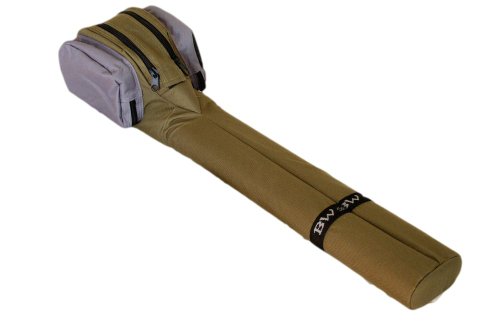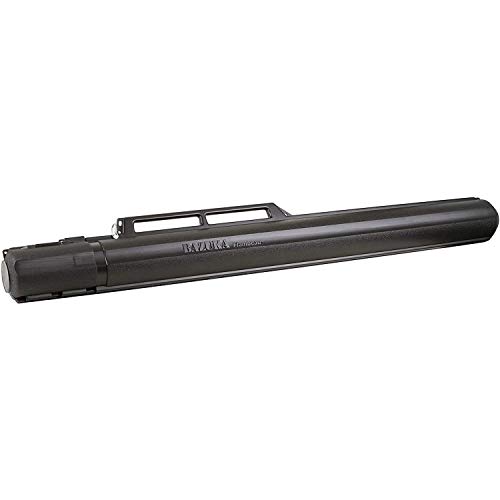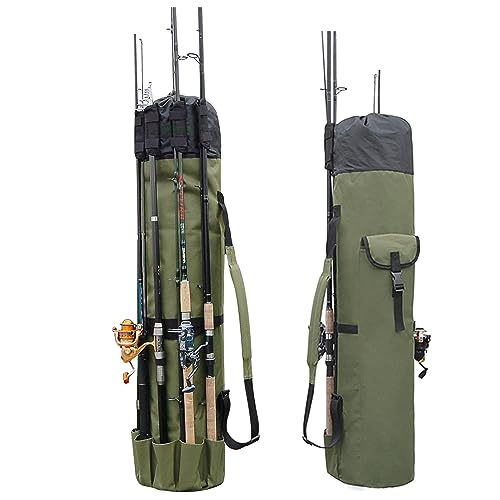How to Travel with Fishing Rods: A Complete Guide
Preparing Your Fishing Rods for Travel
When it comes to traveling with fishing rods, preparation is key to ensure a smooth and enjoyable experience. Whether you're embarking on a weekend getaway or a more extensive fishing expedition, the right equipment and packing techniques can make all the difference. In this section, we'll explore essential considerations for choosing the right fishing rods for traveling and securing them effectively for the journey.
Choosing the Right Fishing Rods for Traveling
Traveling with fishing rods requires careful selection of equipment that balances durability and portability. Traveling anglers often opt for specialized fishing rods designed specifically for mobility and convenience. These innovative rods are crafted to be easily disassembled into several pieces, allowing them to fit snugly into standard-sized luggage. This design not only facilitates hassle-free packing but also ensures that these rods can be conveniently transported as carry-on items, neatly stowed in overhead compartments during air travel.
Considerations for Durability and Portability
The ideal traveling fishing rods are crafted with materials that prioritize both strength and weight efficiency. This balance ensures that they can withstand the rigors of travel while remaining lightweight enough to facilitate easy handling and transportation. Additionally, their collapsible nature makes them versatile for various types of trips, offering anglers the flexibility to indulge in their favorite pastime in diverse locations without being encumbered by bulky equipment.
The Benefits of Travel Rods
Travel rods offer an array of benefits that cater specifically to the needs of mobile anglers. Their compact design not only simplifies packing but also enables seamless transportation, whether by car or air. Furthermore, these versatile rods provide exceptional performance comparable to traditional one-piece models, ensuring that anglers do not have to compromise on quality while on the go.
Securing Your Fishing Rods for the Journey
Once you've selected the appropriate fishing rods for your travels, it's crucial to ensure that they are securely protected throughout your journey. Properly securing your equipment minimizes the risk of damage and guarantees that your gear remains in optimal condition upon arrival at your destination.
Using Rod Tubes and Cases
Investing in rod tubes or cases specifically designed for travel is an effective way to safeguard your fishing rods from potential harm during transit. These protective accessories are engineered to shield delicate rod components from impact and pressure, providing peace of mind as you embark on your adventures.
DIY Solutions for Rod Protection
For those seeking budget-friendly alternatives or wishing to exercise their creativity, DIY solutions can be employed to protect fishing rods during travel. Crafting custom rod sleeves using durable materials such as PVC piping or foam insulation offers a cost-effective approach to safeguarding your equipment without compromising on protection.
By carefully considering these aspects when preparing your fishing rods for travel, you can ensure that your angling pursuits remain enjoyable and stress-free throughout your journey.
Flying with Fishing Rods: The Essentials
As an angler, the prospect of flying to new fishing destinations can be exhilarating. However, navigating airline policies and ensuring a smooth airport experience for your traveling fishing rods is essential for a stress-free journey.
Understanding Airline Policies on Flying with Fishing Rods
Before embarking on your fishing adventure, it's crucial to familiarize yourself with the specific regulations set forth by airlines regarding the transportation of fishing rods. While TSA guidelines generally permit fishing rods in both carry-on and checked bags, it's advisable to verify any size limitations for carry-on items directly with the airline. Each airline maintains its own policy concerning the dimensions, weight restrictions, and packing requirements for fishing poles, emphasizing the need for thorough research prior to your trip.
Size and Weight Restrictions
Airlines typically impose size and weight restrictions on sporting equipment, including traveling fishing rods. It's common for carriers to specify maximum lengths and dimensions allowed for carry-on items, necessitating careful consideration when selecting suitable rod sizes for air travel. Additionally, weight limitations may apply to checked luggage, prompting anglers to prioritize lightweight yet durable rod options that comply with airline regulations.
Fees and Charges for Sporting Equipment
In line with their individual policies, airlines may enforce fees or charges associated with transporting sporting equipment such as fishing rods. These additional costs can vary widely among carriers and are often contingent on factors such as the number of pieces of equipment being transported or whether they are included within checked baggage allowances. As part of your pre-travel preparations, it's advisable to review the fee structures outlined by your chosen airline to anticipate any potential expenses related to flying with your fishing gear.
Tips for Smooth Airport Experiences
Navigating airports with traveling fishing rods requires strategic planning to ensure a seamless transition from check-in to boarding.
Checking In Your Fishing Rods
When checking in at the airport, it's beneficial to communicate openly with airline staff regarding your intention to transport fishing rods. This proactive approach allows them to provide guidance on specific check-in procedures or any additional documentation required for carrying sporting equipment. By adhering to these protocols early in your airport experience, you can mitigate potential delays or complications during the check-in process.
Carry-On vs. Checked Luggage Considerations
Carefully evaluating whether to transport your fishing rods as carry-on or checked luggage is pivotal in optimizing convenience and minimizing risks of damage during transit. While some anglers prefer carrying their rods as part of their carry-on allowance due to concerns about mishandling in checked baggage compartments, others may opt for checking them in alongside other luggage items based on personal preferences or airline regulations. Considering factors such as ease of access during layovers and potential storage space constraints onboard can inform this decision-making process.
By understanding airline policies and implementing strategic approaches at airports when traveling with fishing gear, anglers can enhance their overall travel experiences while safeguarding their valuable equipment throughout their journeys.
Packing Tips for Your Fishing Trip
As an experienced angler, I understand the significance of efficient packing and organizing fishing gear for travel. Whether you're heading to a nearby fishing spot or embarking on a more extensive fishing trip, having the right equipment and organizational strategies can significantly enhance your overall experience.
Essential Gear for Every Fishing Trip
When preparing for a fishing trip, it's crucial to ensure that you have all the essential gear to maximize your chances of success on the water. Here are some key items to consider packing:
Tackles, Lines, and Lures
Carrying a diverse selection of tackles, lines, and lures is fundamental for adapting to various fishing conditions. From vibrant lures designed to attract specific fish species to durable lines capable of withstanding intense battles, having a well-curated assortment ensures that you're equipped for any angling scenario.
Personal Items and Safety Equipment
In addition to fishing-specific gear, it's important to prioritize personal items and safety equipment. This includes essentials such as sunscreen, insect repellent, first-aid supplies, and adequate hydration. Ensuring that you have these items readily available contributes to a safe and comfortable fishing trip.
Organizing Your Fishing Gear for Easy Access
Efficiently organizing your fishing gear not only streamlines your angling pursuits but also minimizes the risk of overlooking critical items when out on the water.
Using Tackle Boxes and Bags
Investing in high-quality tackle boxes or bags offers a systematic approach to organizing your tackles, lines, lures, and other small accessories. These specialized containers feature multiple compartments and adjustable dividers, allowing you to categorize your gear based on functionality or target fish species. Furthermore, transparent lids or clear pockets enable quick visual identification of contents, facilitating swift access during active fishing sessions.
Labeling and Inventory Lists
Creating labeled inventory lists for your fishing gear serves as an effective method for tracking essential items before and after each fishing trip. By systematically documenting your equipment inventory, you can promptly identify any missing or damaged items while also ensuring that nothing is inadvertently left behind at the end of your excursion. Additionally, labeling individual compartments within tackle boxes further enhances organization by providing clear indications of where specific items belong.
By prioritizing essential gear and implementing strategic organizational methods when preparing for a fishing trip, anglers can optimize their time on the water while minimizing potential setbacks associated with disorganized equipment.
Making the Most of Your Fishing Trip
As an avid angler, I understand the excitement and anticipation that come with planning a fishing trip. Choosing the right destination and embracing responsible fishing practices are essential for maximizing the experience while preserving the natural environment.
Choosing Your Fishing Destination
Researching Fishing Spots
When selecting a fishing destination, thorough research is key to identifying prime spots that align with your angling preferences. Local knowledge and insights from experienced anglers can provide valuable guidance on productive fishing locations. Whether it's freshwater lakes teeming with bass or saltwater flats offering opportunities to reel in prized game fish, understanding the unique characteristics of each spot enhances your chances of a successful outing.
Local Regulations and Licenses
Before casting your line in unfamiliar waters, familiarize yourself with local regulations and licensing requirements. Each fishing destination may have specific rules governing catch limits, protected species, and designated conservation areas. Adhering to these regulations not only ensures compliance with environmental conservation efforts but also contributes to sustainable fishing practices that preserve aquatic ecosystems for future generations of anglers.
Enjoying Your Trip Responsibly
Leave No Trace Principles
Embracing Leave No Trace principles is fundamental in minimizing environmental impact during fishing excursions. By following guidelines such as properly disposing of waste, respecting wildlife habitats, and minimizing disturbances to natural surroundings, anglers can actively contribute to maintaining the ecological balance of their chosen fishing destinations.
Catch and Release Best Practices
Incorporating catch and release best practices into your angling endeavors promotes the conservation of fish populations while allowing for continued enjoyment of the sport. Utilizing barbless hooks, handling fish with care to minimize stress, and promptly releasing them back into their habitat fosters sustainable fishing practices. Additionally, capturing memorable photographs of released catches serves as a testament to responsible angling while preserving the aquatic environment.
By prioritizing informed decision-making when selecting fishing destinations and embracing ethical angling practices, anglers can savor fulfilling experiences while safeguarding the natural beauty of diverse aquatic ecosystems.






